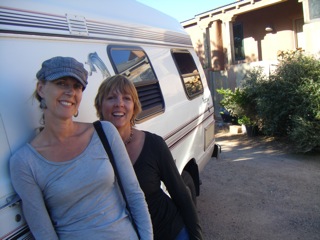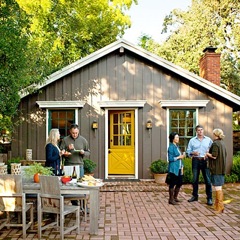Today’s post is by contributing writer Nichole Reber:
“What would it look like if we lived in a community-oriented neighborhood?” Claudia Hartman asks.
For her and Donna Niemann, real communities are places filled with different generations, socio-economic diversity, and sustainable daily living practices. They’re hoping to manifest this in an eco-hybrid model known as Vesta Communities.
The duo took their search for best practices in design, affordability, sustainability and governance on a 2,500-mile journey across Arizona, Utah, Colorado, and New Mexico—and of course the cohousing communities in Tucson and Prescott. They studied 20 private developments such as cohousing, pocket communities, and combinations in between to inform their own proposed socially and environmentally sustainable development.
What is it?
 Neimann’s skills as an artist, designer, and realtor and Hartman’s in marketing communications for the AEC industry have dovetailed well to make Vesta a confluence of progressive community lifestyles. Their plan is to develop multiple communities like this, changing each at least slightly per market trends. For right now, however, the duo is still working on its first development.
Neimann’s skills as an artist, designer, and realtor and Hartman’s in marketing communications for the AEC industry have dovetailed well to make Vesta a confluence of progressive community lifestyles. Their plan is to develop multiple communities like this, changing each at least slightly per market trends. For right now, however, the duo is still working on its first development.
“Cohousing is a good model but our vision is a hybrid concept,” Hartman says. It takes elements she and Neimann witnessed on their 2,500-mile exploration and combined it with old-fashioned practices like boarding houses and some residential elements I’ve only experienced abroad. Two of the most important components of Vesta are eco-friendly design/construction and multi-generationalism. It might also contain a board-and-care aspect and a rental unit or two.
I had a chance to sit with the daring development duo a couple of weeks ago. I confessed to rocking between enthusiasm and skepticism about such communities. Having visited this kind of development in Boston, Florida, Berkeley, and Oakland, I love the communal feel. Residents take care of each other and shed some of the coldness Americans are so fond of. They know their neighbors. Their social lives and skills are an improvement, especially among the children.
Yet whenever the subject of cohousing comes up among people would think say production housing or master-planned communities are a better solution for living, I— like Hartman and Neimann— might as well have the scarlet H for hippie on our chests.
“Aren’t those just communes?”
 No. Residents don’t live together in a singular house and chant “kumbaya” all day. Doctors and architects and teachers and web designers live there, in their own single-family residence that they designed in conjunction with the development’s architect. It’s just that the residences are usually centered around courtyard and many community activities take place in a common area. Each family’s residence contains a kitchen, bedrooms, bathrooms, and anything else found in a traditional model. But things like babysitting, lawn maintenance, errands, carpools, etc. can be shared by the group. Furthermore many of these communities— whether pocket neighborhoods or cohousing developments— have the added bonus of multi-generational residents, which builds better rapport and experience and skill sets amongst each generation.
No. Residents don’t live together in a singular house and chant “kumbaya” all day. Doctors and architects and teachers and web designers live there, in their own single-family residence that they designed in conjunction with the development’s architect. It’s just that the residences are usually centered around courtyard and many community activities take place in a common area. Each family’s residence contains a kitchen, bedrooms, bathrooms, and anything else found in a traditional model. But things like babysitting, lawn maintenance, errands, carpools, etc. can be shared by the group. Furthermore many of these communities— whether pocket neighborhoods or cohousing developments— have the added bonus of multi-generational residents, which builds better rapport and experience and skill sets amongst each generation.
Eschewing the norm
This is all too different for traditional developers. Hence, the duo’s search for a developer who didn’t balk at their plans proved challenging. Finally, however, but Neimann and Hartman have found at least a couple who are willing to participate.
Something else about cohousing concerns me. Yes, more than 200 of such communities exist across the country (and more in Europe). However, this type of development will continue to be situated in the “unorthodox” slot in perpetuity. Lending agencies will continue to look askance at the groups who want to do this themselves because it doesn’t fit into their paradigm.
“We feel that there are lots of people like us who want to do this. We are the consumer,” Hartman says. She adds that she thinks this type of community will become more mainstream especially because more Millennials and elderly want to live like this.
Similar communities around the country and indeed in Europe are growing in popularity because they give the elderly the ability to remain independent yet not isolated. Residents are well equipped by living in the same complex to look after each other. Having children, teens, and young adults around provides rewarding learning experiences for the aforementioned, and in some cases it means that the seniors have someone to take them to their doctor appointments and physical therapy, to the grocery and pharmacy, and otherwise out into the larger community.
Vesta will also likely include a common house. Neimann and Hartman are considering means by which to capitalize on the large space such as placing a café or luncheonette in it for the public’s enjoyment. After closing hours it would serve as the community’s main kitchen.
On a mission
 Vesta may take a while to get off the ground but these ladies are determined. They’re dedicated. Neimann is so passionate about the project that she earned her Realtor’s license. When Katie McCamant and Chuck Durrett— the pioneers behind cohousing—realized “this one won’t take no for an answer,” they allowed Neimann to spend a week with them. There she learned cohousing from the inside and learned to prevent mistakes common in similar communities.
Vesta may take a while to get off the ground but these ladies are determined. They’re dedicated. Neimann is so passionate about the project that she earned her Realtor’s license. When Katie McCamant and Chuck Durrett— the pioneers behind cohousing—realized “this one won’t take no for an answer,” they allowed Neimann to spend a week with them. There she learned cohousing from the inside and learned to prevent mistakes common in similar communities.
Since Neimann and Hartman kicked the project off three years ago, they have also worked with Project Rising to edify themselves about land use and glean insight into another side of the development process. When not debating which architectural style to incorporate— Neimann prefers organic while Hartman favors mid-century Modernism— they’re also investigating alternative finance models.
The potential problems of developing and living in such a community haven’t been lost on me. But I’ve seen the community lifestyle from coast to coast. Seen how generations intermingle. Watched people do things for and with each other. Witnessed neighbors who knew each others’ names. Does that sound like a bad place to live?
Learn more about:
The Cohousing Association of the US
The architects of American cohousing, Kathryn McCamant and Charles Durrett of The Cohousing Company
Ross Chapin, the pioneer of pocket neighborhood
Photo Credit: Lead image is a photo of the Pleasant Hill Cohousing Community from The Cohousing Company. All other photos courtesy of Vesta Communities.




















Glad to see news of Claudia and Donna’s work/passion being spread. Although I find the term co-housing too governmental and lacking passion, what it stands for is important.
The need for cooperative living space is on the rise and thank the Gods people like Donna & Claudia are making it their mission.
Good article, good cause… now we just need to see funding to make it more than a dream.
Great work Claudia and Donna! Co-housing is so right, and so right now – I’m proud to know you and proud of the stand that you have taken for community in our city!
I was part of a small group that explored the co-housing concept in Phoenix about 20 years ago. Would love to see something come to fruition here. Love the ‘organic’ idea of development. Please send me information on the next gathering of interested participants! And thank you for your efforts on this project! Jane
I am 60 no kids living in phx and had an israeli kibbutz/moshav stay of 1.5 years…many modern kibbutzim are similar with private residences and shared responsibility…I see the challenges of zoning in munis but bet that like myself many would be very interested in this living option
I am a musician/teacher/storyteller currently living on the East Coast in an shared housing situation Looking for a similar community in Phoenix area within the next couple of years. Please let me know of your progress and or any other projects in the area. I am coming out this May 2016 Would love to meet you to discuss. I hope to hear from you. Sincerely, Lauren Hooker
I am new to this concept , but I have come to think that I need this type of community so I can thrive. I was considering developing it and voila, it is already well underway with many variations. Please let me know more about these projects. I live in Phoenix. How far have you gotten?
Any updates on the status of this project? Would love to see an update and current challenges.
I’ve been dreaming of this for Cave Creek for so long.